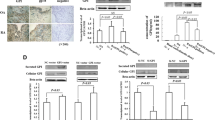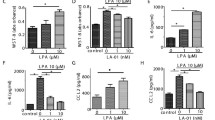Abstract
β1,4-Galactosyltransferase-I (β1,4-GalT-I), which transfers galactose to the terminal N-acetylglucosamine of N- and O-linked glycans in a β1,4-linkage, is considered to be the major galactosyltransferase among the seven members of the subfamily responsible for β4 galactosylation. We previously reported, for the first time, that β1,4-GalT-I may play an important role in the inflammatory processes in synovial tissue of patients with rheumatoid arthritis (RA). In this study, we analyzed whether β1,4-GalT-I expression correlates with the expression of tumor necrosis factor-α (TNF-α) in RA. We show firstly the overexpression and co-localization of β1,4-GalT-I and TNF-α in synovial tissue of RA patients. Then, lipopolysaccharide (LPS) induces β1,4-GalT-I mRNA up-regulation in fibroblast-like synoviocytes (FLSs) through endogenous TNF-α overexpression. In addition, we observed that not only endogenous TNF-α but also exogenous TNF-α induced β1,4-GalT-I mRNA production in FLSs, and TNF-α-knockdown reverses the up-regulation of β1,4-GalT-I in FLSs induced by LPS or TNF-α. These results suggest that TNF-α contributes to the up-regulation of β1,4-GalT-I mRNA in human FLSs.





Similar content being viewed by others
REFERENCES
Joosten, L.A., T.R. Radstake, E. Lubberts, L.A. van den Bersselaar, P.L. van Riel, P.L. van Lent, P. Barrera, and W.B. van den Berg. 2003. Association of interleukin-18 expression with enhanced levels of both interleukin-1beta and tumor necrosis factor alpha in knee synovial tissue of patients with rheumatoid arthritis. Arthritis and Rheumatism 48: 339–347.
Apweiler, R., H. Hermjakob, and N. Sharon. 1999. On the frequency of protein glycosylation, as deduced from analysis of the SWISS-PROT database. Biochimica et Biophysica Acta 1473: 4–8.
Furukawa, K., and T. Sato. 1999. Beta-1, 4-galactosylation of N-glycans is a complex process. Biochimica et Biophysica Acta 1473: 54–66.
Shur, B.D., S. Evans, and Q. Lu. 1998. Cell surface galactosyltransferase: current issues. Glycoconjugate Journal 15: 537–548.
Hathaway, H.J., and B.D. Shur. 1992. Cell surface beta 1, 4-galactosyltransferase functions during neural crest cell migration and neurulation in vivo. The Journal of Cell Biology 117: 369–382.
Eckstein, D.J., and B.D. Shur. 1992. Cell surface beta-1, 4-galactosyltransferase is associated with the detergent-insoluble cytoskeleton on migrating mesenchymal cells. Experimental Cell Research 201: 83–90.
Miller, D.J., M.B. Macek, and B.D. Shur. 1992. Complementarity between sperm surface beta-1, 4-galactosyltransferase and egg-coat ZP3 mediates sperm–egg binding. Nature 357: 589–593.
Evans, S.C., L.C. Lopez, and B.D. Shur. 1993. Dominant negative mutation in cell surface beta 1, 4-galactosyltransferase inhibits cell–cell and cell–matrix interactions. The Journal of Cell Biology 120: 1045–1057.
Huang, Q., B.D. Shur, and P.C. Begovac. 1995. Overexpressing cell surface beta 1.4-galactosyltransferase in PC12 cells increases neurite outgrowth on laminin. Journal of Cell Science 108(Pt 2): 839–847.
Maillet, C.M., and B.D. Shur. 1994. Perturbing cell surface beta-(1, 4)-galactosyltransferase on F9 embryonal carcinoma cells arrests cell growth and induces laminin synthesis. Journal of Cell Science 107(Pt 6): 1713–1724.
Asano, M., S. Nakae, N. Kotani, N. Shirafuji, A. Nambu, N. Hashimoto, H. Kawashima, M. Hirose, M. Miyasaka, S. Takasaki, and Y. Iwakura. 2003. Impaired selectin–ligand biosynthesis and reduced inflammatory responses in beta-1, 4-galactosyltransferase-I-deficient mice. Blood 102: 1678–1685.
Mori, R., T. Kondo, T. Nishie, T. Ohshima, and M. Asano. 2004. Impairment of skin wound healing in beta-1, 4-galactosyltransferase-deficient mice with reduced leukocyte recruitment. The American Journal of Pathology 164: 1303–1314.
Arend, W.P., and J.M. Dayer. 1995. Inhibition of the production and effects of interleukin-1 and tumor necrosis factor alpha in rheumatoid arthritis. Arthritis and Rheumatism 38: 151–160.
Feldmann, M., F.M. Brennan, and R.N. Maini. 1996. Role of cytokines in rheumatoid arthritis. Annual Review of Immunology 14: 397–440.
Collins, T., M.A. Read, A.S. Neish, M.Z. Whitley, D. Thanos, and T. Maniatis. 1995. Transcriptional regulation of endothelial cell adhesion molecules: NF-kappa B and cytokine-inducible enhancers. The FASEB Journal 9: 899–909.
Lowe, J.B. 2003. Glycan-dependent leukocyte adhesion and recruitment in inflammation. Current Opinion in Cell Biology 15: 531–538.
Wang, Y., D. Xu, R. Tao, H. Wang, Q. Wang, and A. Shen. 2010. beta1,4-Galactosyltransferase-I contributes to the inflammatory processes in synovial tissue of patients with rheumatoid arthritis. Inflammation Research. doi:10.1007/s00011-010-0217-1
Arnett, F.C., S.M. Edworthy, D.A. Bloch, D.J. Mcshane, J.F. Fries, N.S. Cooper, L.A. Healey, S.R. Kaplan, M.H. Liang, H.S. Luthra, and A. Et. 1988. The American Rheumatism Association 1987 revised criteria for the classification of rheumatoid arthritis. Arthritis and Rheumatism 31: 315–324.
Prevoo, M.L., M.A. van’t Hof, H.H. Kuper, M.A. van Leeuwen, L.B. van de Putte, and P.L. van Riel. 1995. Modified disease activity scores that include 28-joint counts. Development and validation in a prospective longitudinal study of patients with rheumatoid arthritis. Arthritis and Rheumatism 38: 44–48.
Radstake, T.R., M.F. Roelofs, Y.M. Jenniskens, B. Oppers-Walgreen, P.L. van Riel, P. Barrera, L.A. Joosten, and W.B. van den Berg. 2004. Expression of toll-like receptors 2 and 4 in rheumatoid synovial tissue and regulation by proinflammatory cytokines interleukin-12 and interleukin-18 via interferon-gamma. Arthritis and Rheumatism 50: 3856–3865.
Vervoordeldonk, M.J., and P.P. Tak. 2002. Cytokines in rheumatoid arthritis. Current Rheumatology Reports 4: 208–217.
Kamijo, S., A. Nakajima, K. Kamata, H. Kurosawa, H. Yagita, and K. Okumura. 2008. Involvement of TWEAK/Fn14 interaction in the synovial inflammation of RA. Rheumatology (Oxford) 47: 442–450.
Bartok, B., and G.S. Firestein. 2010. Fibroblast-like synoviocytes: key effector cells in rheumatoid arthritis. Immunological Reviews 233: 233–255.
Take, Y., K. Nakata, J. Hashimoto, H. Tsuboi, N. Nishimoto, T. Ochi, and H. Yoshikawa. 2009. Specifically modified osteopontin in rheumatoid arthritis fibroblast-like synoviocytes supports interaction with B cells and enhances production of interleukin-6. Arthritis and Rheumatism 60: 3591–3601.
Settles, B., A. Stevenson, K. Wilson, C. Mack, T. Ezell, M.F. Davis, and L.D. Taylor. 2001. Down-regulation of cell adhesion molecules LFA-1 and ICAM-1 after in vitro treatment with the anti-TNF-alpha agent thalidomide. Cell Molecular Biology (Noisy-le-grand) 47: 1105–1114.
Gonzalez-Gay, M.A., M.T. Garcia-Unzueta, J.M. De Matias, C. Gonzalez-Juanatey, C. Garcia-Porrua, A. Sanchez-Andrade, J. Martin, and J. Llorca. 2006. Influence of anti-TNF-alpha infliximab therapy on adhesion molecules associated with atherogenesis in patients with rheumatoid arthritis. Clinical and Experimental Rheumatology 24: 373–379.
Lowe, J.B. 1997. Selectin ligands, leukocyte trafficking, and fucosyltransferase genes. Kidney International 51: 1418–1426.
McEver, R.P., K.L. Moore, and R.D. Cummings. 1995. Leukocyte trafficking mediated by selectin–carbohydrate interactions. The Journal of Biological Chemistry 270: 11025–11028.
Hiraoka, N., B. Petryniak, J. Nakayama, S. Tsuboi, M. Suzuki, J.C. Yeh, D. Izawa, T. Tanaka, M. Miyasaka, J.B. Lowe, and M. Fukuda. 1999. A novel, high endothelial venule-specific sulfotransferase expresses 6-sulfo sialyl Lewis(x), an L-selectin ligand displayed by CD34. Immunity 11: 79–89.
Maemura, K., and M. Fukuda. 1992. Poly-N-acetyllactosaminyl O-glycans attached to leukosialin. The presence of sialyl Le(x) structures in O-glycans. The Journal of Biological Chemistry 267: 24379–24386.
Wilkins, P.P., R.P. McEver, and R.D. Cummings. 1996. Structures of the O-glycans on P-selectin glycoprotein ligand-1 from HL-60 cells. The Journal of Biological Chemistry 271: 18732–18742.
Kotani, N., M. Asano, Y. Iwakura, and S. Takasaki. 2001. Knockout of mouse beta 1, 4-galactosyltransferase-1 gene results in a dramatic shift of outer chain moieties of N-glycans from type 2 to type 1 chains in hepatic membrane and plasma glycoproteins. The Biochemical Journal 357: 827–834.
Garcia-Vallejo, J.J., W. van Dijk, I. van Die, and S.I. Gringhuis. 2005. Tumor necrosis factor-alpha up-regulates the expression of beta1, 4-galactosyltransferase I in primary human endothelial cells by mRNA stabilization. The Journal of Biological Chemistry 280: 12676–12682.
Yan, M., C. Xia, S. Niu, X. Shao, C. Cheng, J. Zhao, and A. Shen. 2007. The role of TNF-alpha and its receptors in the production of beta-1, 4 galactosyltransferase I and V mRNAs by rat primary astrocytes. Journal of Molecular Neuroscience 33: 155–162.
ACKNOWLEDGMENTS
This work was supported by the National Natural Scientific Foundation of China Grant (No. 30770488, No. 31070723, and No. 81070275), Natural Scientific Foundation of Jiangsu Province Grant (No. BK2006547), College and University Natural Scientific Research Programme of Jiangsu Province (No. 03KJB180109), and “Ke-Jiao-Xing-Wei-Zhong-Dian-Yi-Xue-Ren-Cai” Financial Assistance of Jiangsu Province (RC2007087).
Author information
Authors and Affiliations
Corresponding author
Rights and permissions
About this article
Cite this article
Xu, D., Cui, Z., Liu, W. et al. Tumor Necrosis Factor-α Up-Regulates the Expression of β1,4-Galactosyltransferase-I in Human Fibroblast-like Synoviocytes. Inflammation 34, 531–538 (2011). https://doi.org/10.1007/s10753-010-9260-x
Published:
Issue Date:
DOI: https://doi.org/10.1007/s10753-010-9260-x




